Equestrian chic style is a sartorial embodiment of British aristocratic elegance and traces its roots to the 18th-century hunting fields of England.
Born from pursuing sport and leisure, this unique fashion style has evolved from practical riding attire into a sophisticated aesthetic at the pinnacle of modern menswear.
Nowadays, the equestrian chic fashion style is a visual shorthand for refinement, heritage, and social standing.
As we delve deeper into equestrian chic, we will explore how this quintessentially British fashion style has shaped the landscape of men’s fashion, influencing everything from everyday attire to the highest echelons of formal wear.
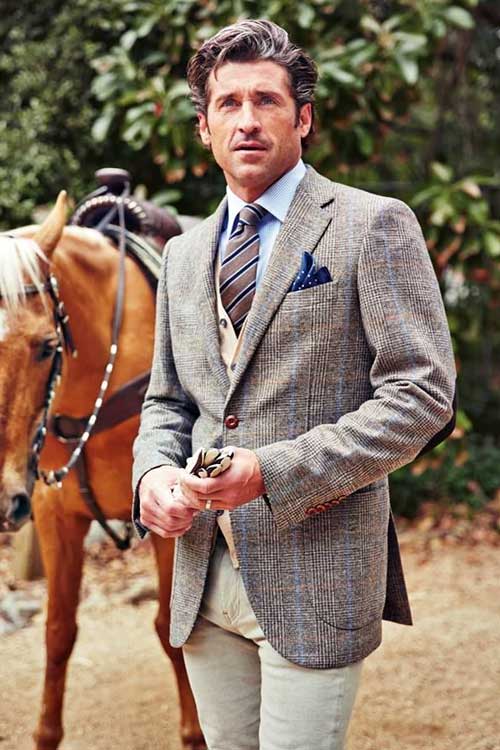 |
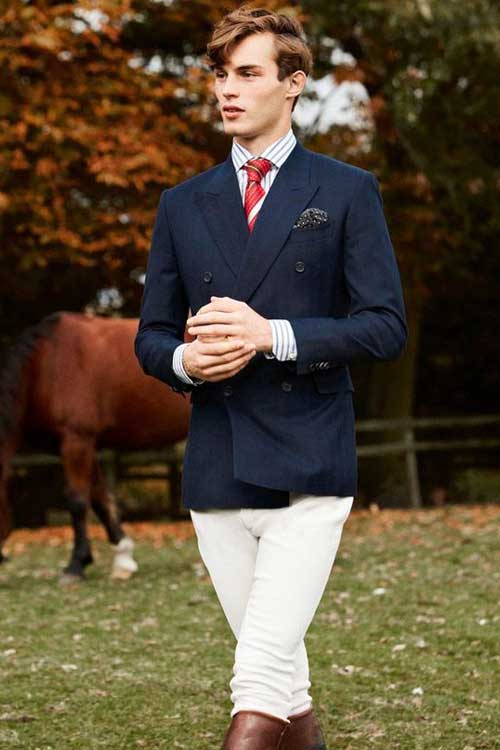 |
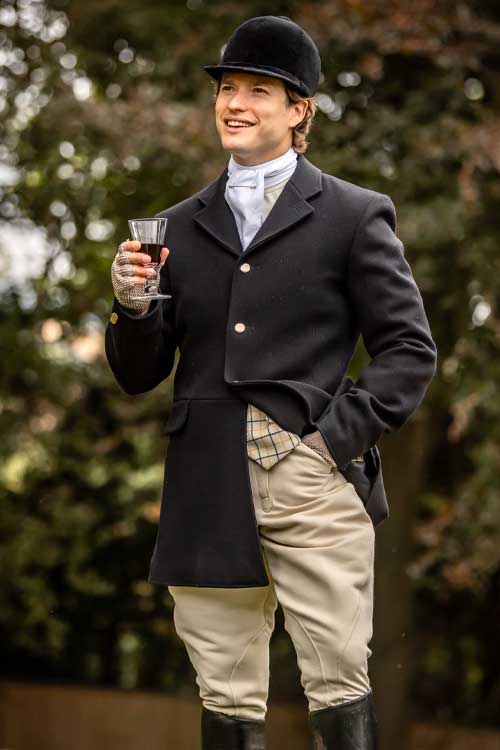 |
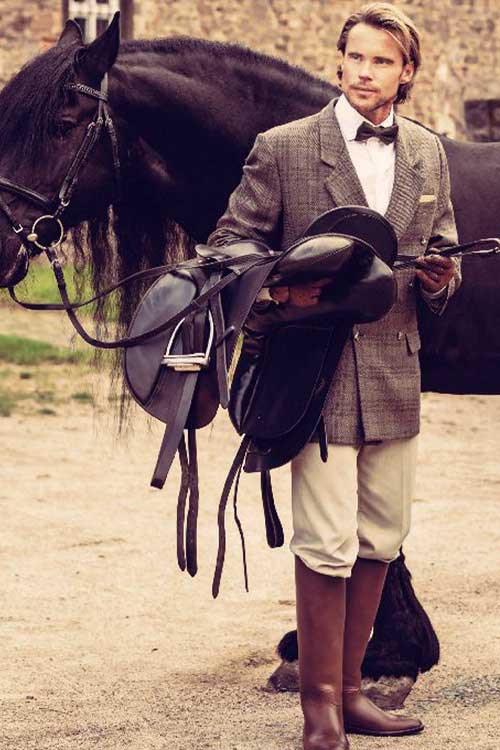 |
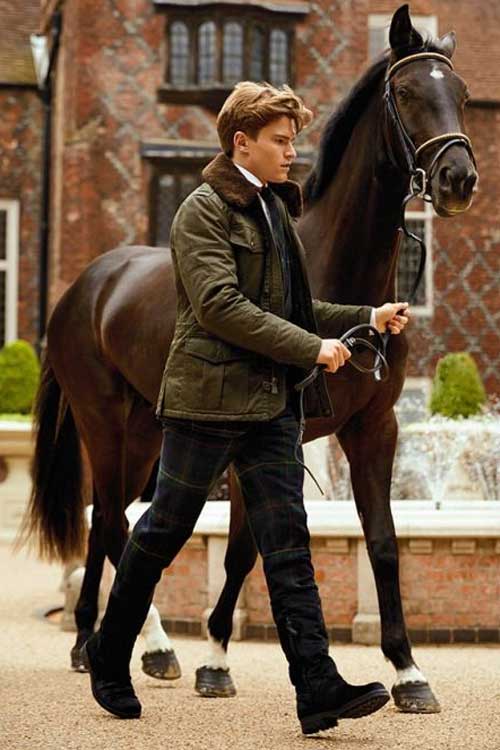 |
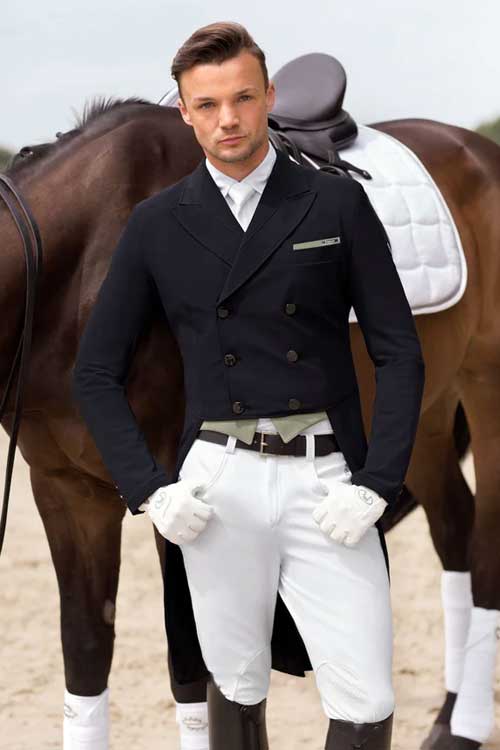 |
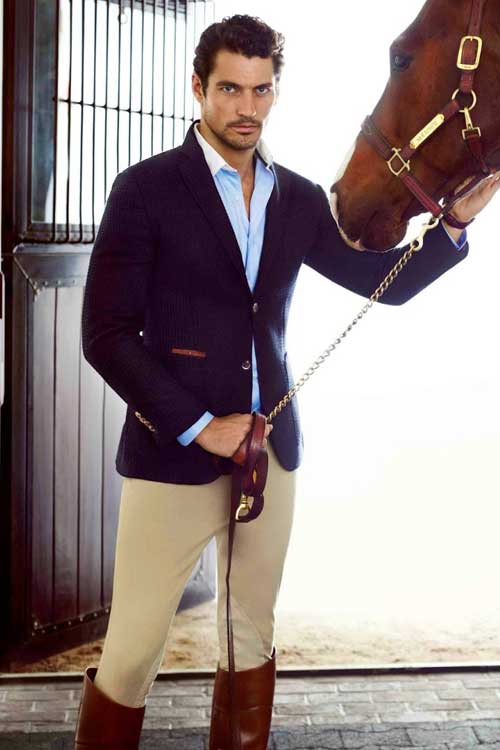 |
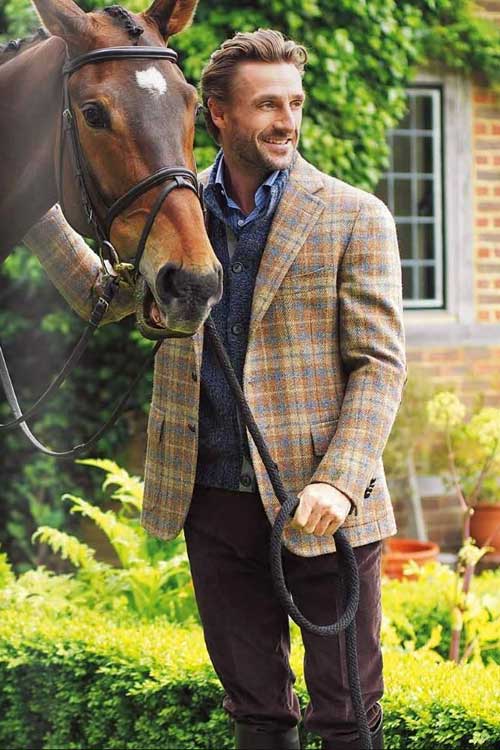 |
Equestrian Style Beyond the Paddock
The sartorial world of equestrian sports extends far beyond the functional attire worn in the saddle, profoundly influencing aristocratic fashion off the horse.
Each equestrian discipline has contributed unique elements to this refined style, transforming riding wear into potent symbols of class and refinement.
| Style | Key Garments | Colours | Influence on Equestrian Chic |
|---|---|---|---|
| Dressage | Tailcoat | Black and White | Dinner jackets
Formal shirt bibs and cuffs Evening wear |
| White breeches | |||
| Top boots | |||
| Stock tie | |||
| Show Jumping | Show jacket | Navy, Black | Classic blazers
Sports jackets with functional cut Smart-casual trousers |
| Light-coloured breeches | Beige, White | ||
| Leather boots | Brown | ||
| Fox Hunting | Scarlet coat (‘pink’) | Scarlet, White | Morning coats
Formal daywear Tweed jackets for country wear Strict dress codes for social events |
| Pale breeches | Fawn, Cream | ||
| Tall boots | Black | ||
| Hunting cap | Black | ||
| General Riding | Jodhpurs | Beige, White | Trouser cut styles
Boots fashion Smart-casual jackets Formal neckwear |
| Riding boots | Brown, Black | ||
| Tweed jackets | Earth tones | ||
| Stock ties | White, Patterned |
Dressage – Epitome of Elegance
Dressage, the balletic discipline of horse riding, demands a formal and elegant appearance.
The dressage tailcoat, with a precise cut and stark contrast between black, dark grey, or navy blue fabric and white shirt, has become a template for evening wear.
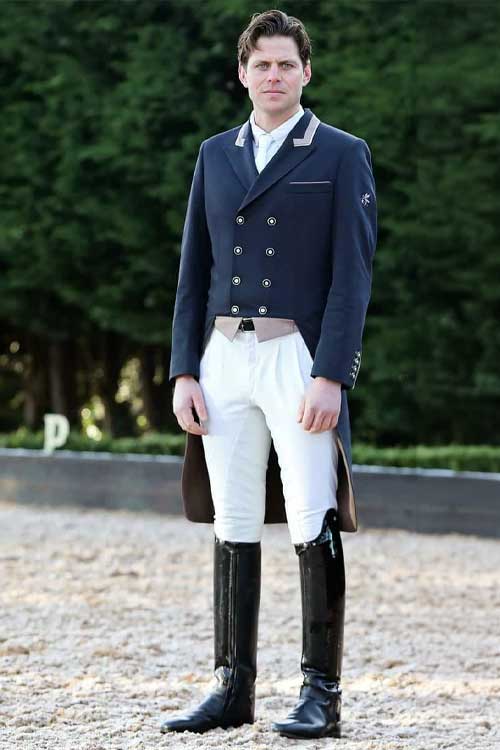 |
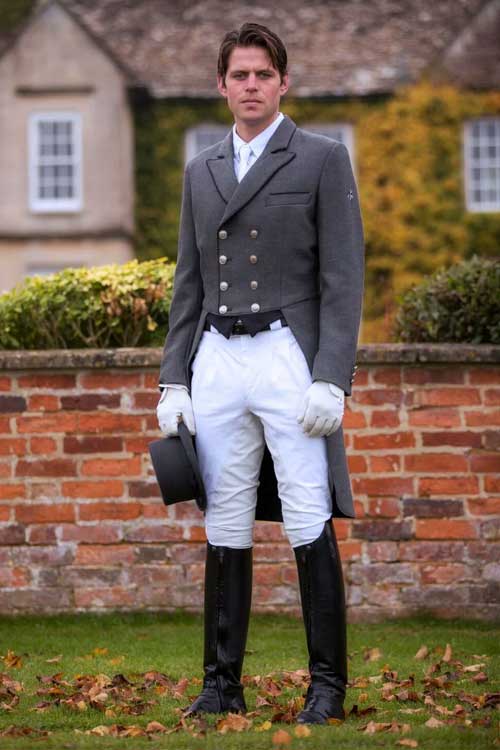 |
This influence is evident in the dinner jacket or ‘tuxedo’, which shares its lineage with the dressage coat.
The stringent requirements of dressage attire—immaculate white breeches, polished top boots, and crisp stocks—have instilled a sense of meticulous grooming in aristocratic fashion.
Show Jumping – Functional Fashion
While less formal than dressage, show jumping has also contributed significantly to equestrian chic.
The show jacket, typically navy or black, has evolved into the classic blazer—a staple of the aristocratic wardrobe.
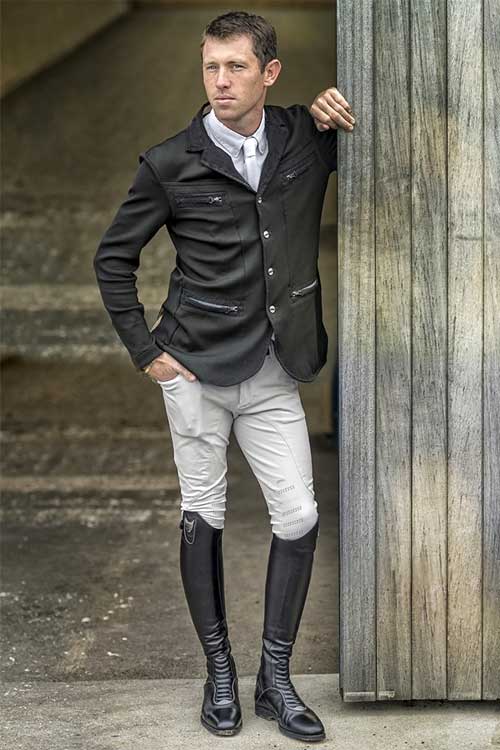 |
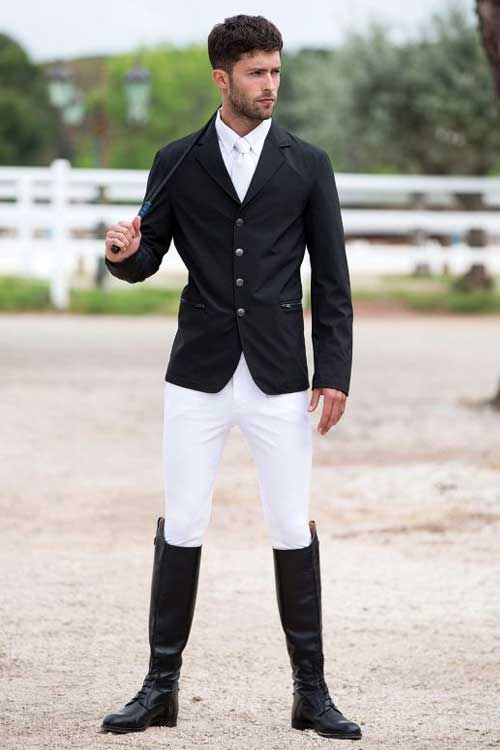 |
Show jumping attire allows freedom of movement and has influenced the cut of sports jackets and lounge suits, promoting an elegant yet functional silhouette.
The elbow patches, originally for the rider’s protection against branches while riding outdoors, have become a hallmark of old money style in academic and country settings.
Fox Hunting – British Tradition
Perhaps the most quintessentially British of equestrian pursuits, Fox hunting has profoundly impacted aristocratic style.
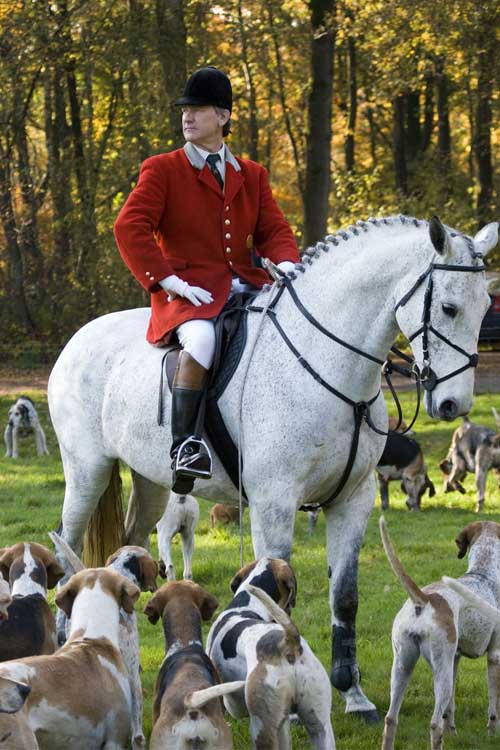
The iconic scarlet hunting coat or ‘pink’ has become a symbol of tradition and status, influencing the design of the morning coat, a staple of formal daywear.
The hunt’s strict dress code, including pale breeches, tall boots, and hunting caps, has cultivated a sense of sartorial propriety that permeates upper-class fashion.
From Functionality to Refinement
The transformation of these functional garments into symbols of refinement is evident in their adoption beyond equestrian circles.
The stock tie, originally worn to protect a rider’s neck, has become a marker of formality in upper-class events.
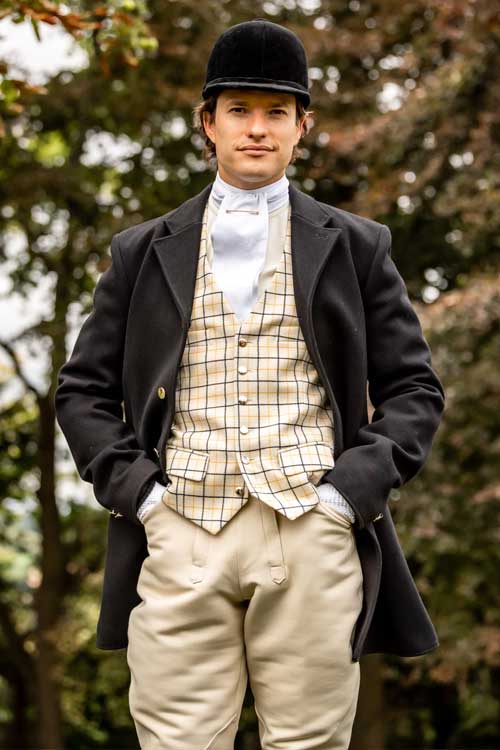 |
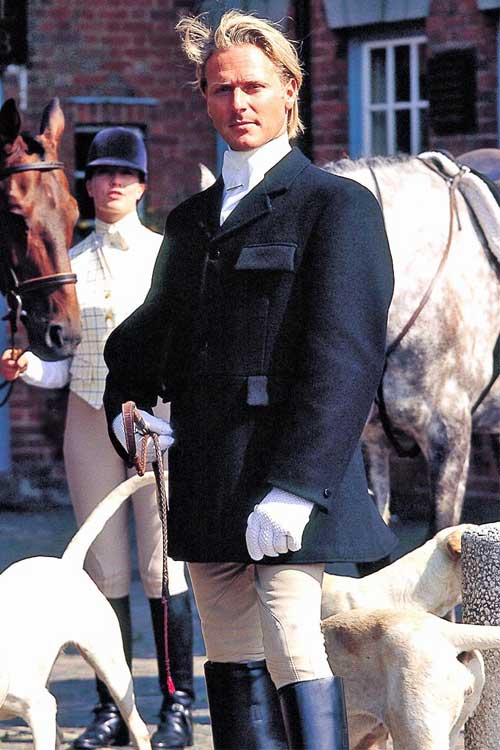 |
Once worn for countryside rides, sturdy tweed jackets are now embraced as smart-casual wear.
Their durability and classic patterns lend an air of timeless sophistication.
The subtle inclusion of details like throat latches on overcoats harkens back to their equestrian origins.
Jodhpurs and Riding Boots Evolution
Jodhpurs and riding boots have undergone perhaps the most dramatic transformation. Once purely functional, these items have been reinterpreted for everyday wear.
The jodhpur’s distinct silhouette, tight-fitting from knee to ankle, has influenced the design of trousers and even casual wear like skinny jeans.
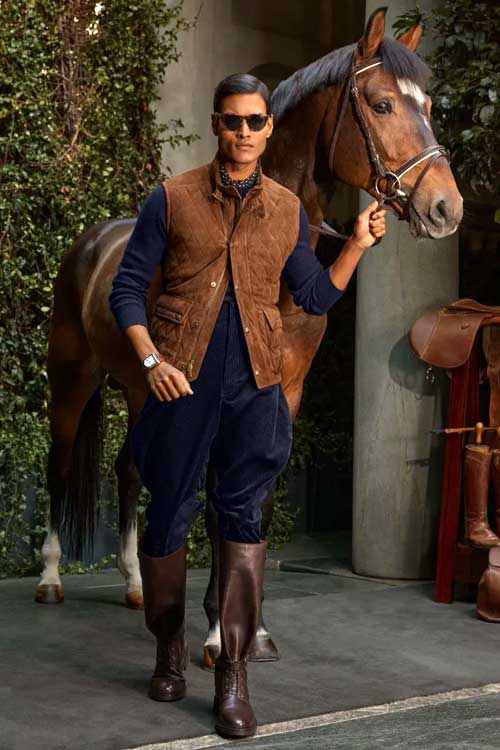
Riding boots, particularly in their sleeker, more refined forms, have become a fashion statement far removed from their equestrian origins, often featuring in high-end fashion collections.
Craftsmanship Details
The influence of equestrian style on aristocratic fashion is also evident in the attention to detail and quality of craftsmanship.
The robust construction necessary for riding wear has translated into an expectation of durability and excellence in all aspects of the aristocratic wardrobe.
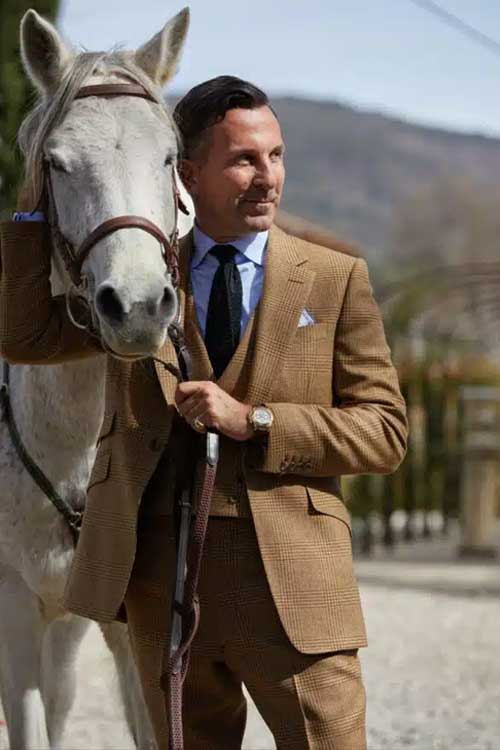 |
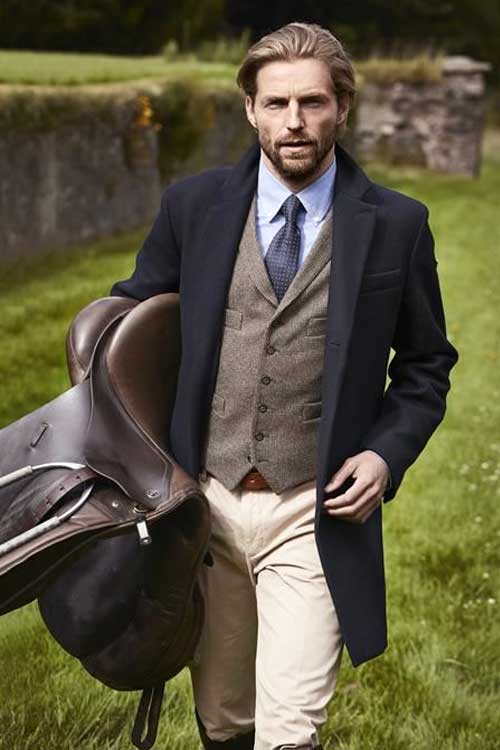 |
This emphasis on quality over quantity, on investment pieces rather than disposable fashion, is a hallmark of upper-class style.
Details such as reinforced seams, horn buttons, and hand-stitched buttonholes are subtle nods to this equestrian heritage.
Equestrian-chic Fabrics, Patterns, and Colours
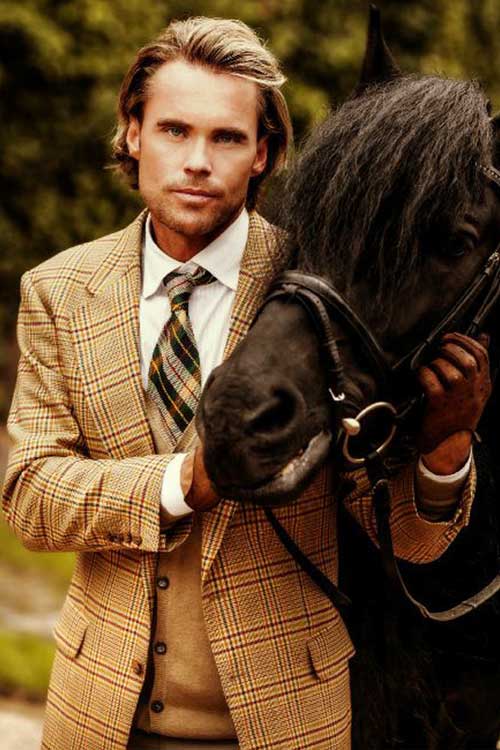
Fabrics
Tweed dominates equestrian-inspired fashion. Harris Tweed, woven from pure virgin wool, offers durability and warmth.
Barleycorn and herringbone tweed patterns add texture to jackets and waistcoats.
Worsted wool, with its smooth finish, is ideal for tailored trousers and formal jackets. Super 120s and 150s wool provide a luxurious hand-feel and drape.
Melton cloth, a dense, weather-resistant wool, is the choice for hunting coats and winter outerwear. Its felted surface repels wind and light rain.
Cavalry twill, a durable worsted fabric with diagonal ribs, is perfect for riding breeches and smart casual trousers.
Patterns
Tattersall check, a pattern of dark lines forming squares on a light background, is a staple in equestrian shirts and waistcoats.
Houndstooth, a duotone textile pattern of broken checks, features prominently in jackets and overcoats.
Glen plaid, also known as Prince of Wales check, adds sophistication to suits and sports jackets.
Pinstripes, originating from formal riding trousers, are now featured in business suits and formal wear.
Colours
Hunter green, a deep, rich shade, is synonymous with country pursuits and features in jackets and accessories.
Navy blue serves as a versatile base colour for blazers, trousers, and outerwear.
Burgundy, reminiscent of traditional hunting coats, adds warmth to ties, pocket squares, and knitwear.
Inspired by riding breeches, tan and beige are essential for trousers and casual wear.
Cream and ivory provide contrast in shirts, sweaters, and summer jackets.
Earth tones like brown, khaki and olive green reflect the natural environment of equestrian sports and complement the overall palette.
Equestrian Chic Wardrobe Essentials
The equestrian-inspired wardrobe is built upon a foundation of classic pieces that seamlessly blend function and fashion.
These garments and accessories, steeped in tradition, form the cornerstones of the equestrian chic style.
The Scarlet Hunting Coat Legacy
The scarlet hunting coat, colloquially known as ‘pink’, is an iconic symbol of equestrian tradition.
The scarlet hunting coat is crafted from heavy Melton wool. It has a single-breasted cut, notched lapels, and gleaming brass buttons.
The coat’s influence extends beyond the hunting field, inspiring the design of formal morning coats and military dress uniforms.
Hacking Jackets and Norfolk Jackets
The hacking jacket, a single-breasted, semi-fitted coat with a slightly longer length, epitomises country elegance.
Made from tweed, the hacking jacket features slanted pockets, a single vent, and sports leather buttons.
The Norfolk jacket, distinguished by its belt and box pleats, offers a more robust alternative for outdoor pursuits.
Both styles have significantly influenced modern sports jacket design.
Tailcoats Influence on Formal Wear
The evolution of the riding coat into the tailcoat marks a pivotal moment in men’s fashion history.
The cutaway front, designed for comfort while seated on horseback, became a defining feature of formal evening wear.
Today’s white tie ensembles owe their silhouette to this equestrian origin.
Riding Blazers and Jackets
The classic navy blazer, with its nautical-inspired brass buttons, shares DNA with equestrian attire.
Modern iterations often incorporate subtle nods to riding gear, such as ticket pockets or suede elbow patches.
Tweed sports jackets, direct descendants of country riding attire, remain a staple of the equestrian-inspired wardrobe.
Trousers and Breeches
Jodhpurs and breeches, with their distinctive fit—tight from the knee down—have left an indelible mark on trouser design.
High-waisted and often featuring reinforced inner knees, these riding trousers have influenced everything from military uniforms to contemporary slim-fit styles.
Footwear – From Riding Boots to Jodhpur Boots
Tall riding boots, crafted from supple leather with a sturdy sole, embody both practicality and elegance.
Their shorter counterpart, the Jodhpur boot, has transcended its equestrian origins to become a versatile fashion staple.
The Chelsea boot, with its elastic side panels, also traces its lineage to riding footwear.
Accessories – Stocks, Ties, and Hats
The stock tie, a wide cravat secured with a pin, originates from the hunting field and has become a marker of formality in equestrian circles.
Traditional silk ties in regimental stripes or foulard patterns echo the colours of riding clubs.
Headwear, from the venerable bowler hat to tweed flat caps, completes the equestrian-inspired ensemble.
These garments, footwear, and accessories convey heritage and understated elegance, making them essential to the equestrian chic fashion style.
Equestrian Style Outfit Ideas Beyond the Stables
Spring
Start with a lightweight navy hopsack blazer with brass buttons, stone-coloured cotton twill chinos, and a Bengal-striped Oxford cloth button-down in light blue and white underneath.
Wear brown suede penny loafers without socks and accessorise with a silk pocket square featuring an equestrian motif in blue and white, a navy and white leather D-ring belt, and a rose gold dress watch with a navy face and brown leather strap.
Summer
Start with a linen-cotton blend blazer in blue and white seersucker and a white piqué cotton polo shirt with mother-of-pearl buttons.
For a Southern American preppy touch, pair with Nantucket red Bermuda shorts and brown leather boat shoes without socks.
Accessorise with a braided leather belt in navy and white, a stainless steel dive watch with a navy face and matching NATO strap and a canvas sailing cap with a discreet equestrian motif.
Autumn
Start with a cream cable-knit cashmere sweater over a light blue Oxford cloth button-down and rich burgundy moleskin trousers.
Layer with a navy quilted gilet and pair with chocolate brown suede chukka boots.
Accessorise with a wool-silk blend scarf in navy and burgundy repp stripe, a brown leather belt, a gold-toned dress watch on a brown leather strap, and tortoiseshell clubmaster sunglasses.
Winter
Start with a navy double-breasted reefer coat in heavy Melton wool and a Fair Isle sweater in cream, navy, and burgundy over a white pinpoint Oxford cloth button-down.
Match with charcoal grey flannel trousers with a forward pleat and burgundy cordovan leather cap-toe boots.
Accessorise with a navy and grey houndstooth cashmere scarf and dark brown leather gloves.
Complete the look with a navy wool flat cap, a rose gold chronograph watch, and a black alligator strap.
Equestrian Fashion Icons
These people have shaped the style, influenced fashion, and demonstrated the enduring appeal of equestrian-inspired clothing across various contexts and generations.
Beau Brummell – the Regency dandy, refined equestrian style in the early 19th century. His perfectly tailored riding coats and polished boots set new standards for men’s fashion.
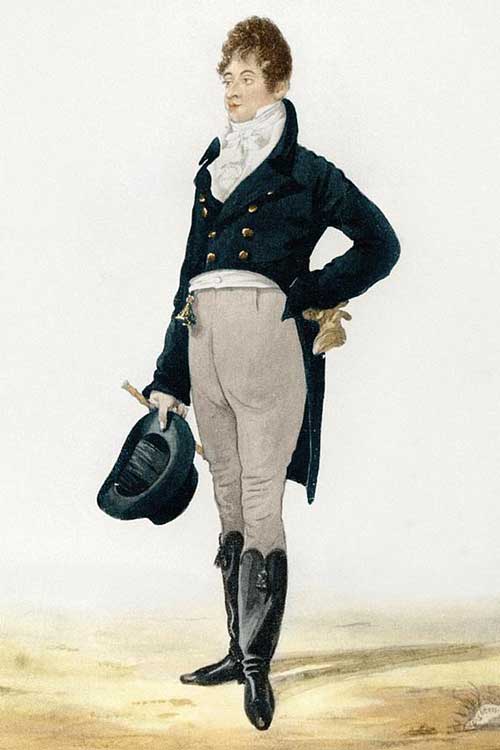
Edward VII, as Prince of Wales – popularised the Norfolk jacket for country pursuits. His preference for tweed shooting suits influenced aristocratic casual wear. He brought equestrian elements into mainstream fashion. His innovative mix of patterns and textures in riding attire inspired modern menswear.
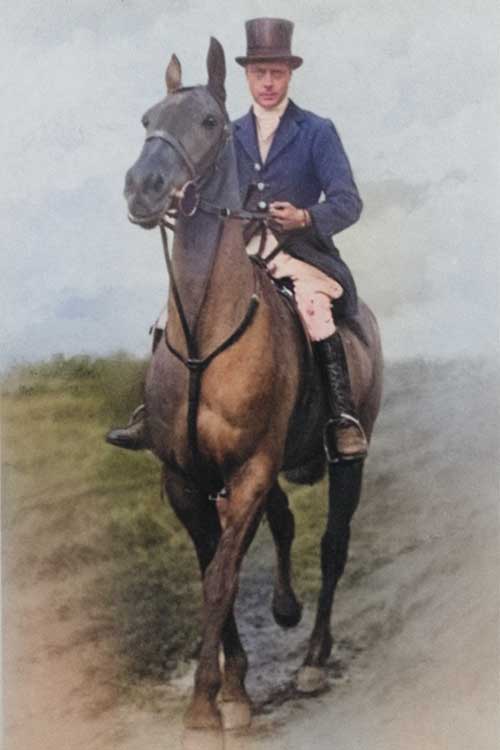
Prince Philip, Duke of Edinburgh – epitomised classic equestrian style. His impeccably cut riding jackets and jodhpurs showcased traditional British tailoring.
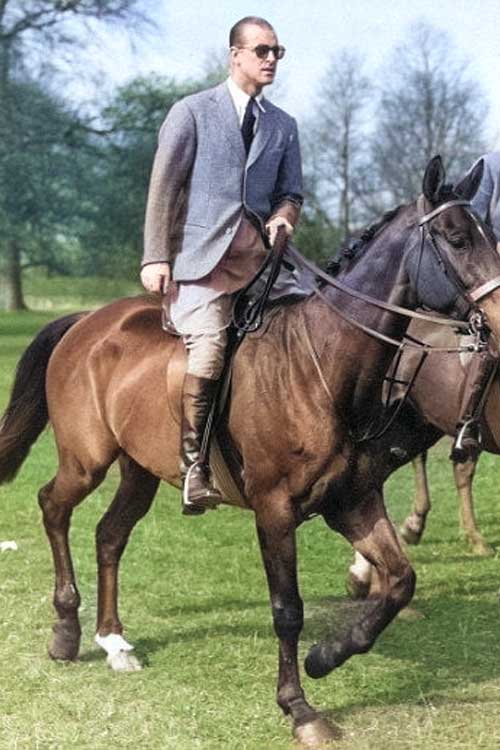
King Charles III – continues to champion equestrian-inspired fashion. His double-breasted suits and country tweeds reflect his passion for traditional craftsmanship.
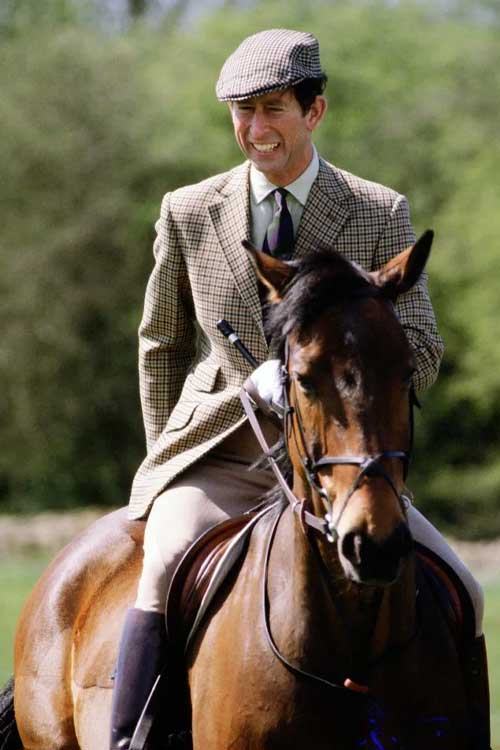
Prince Edward, Duke of Edinburgh – embodied a modern yet refined equestrian style. His preference for streamlined riding jackets and tailored breeches reflects a contemporary approach to traditional British equestrian fashion, blending functionality with understated elegance.
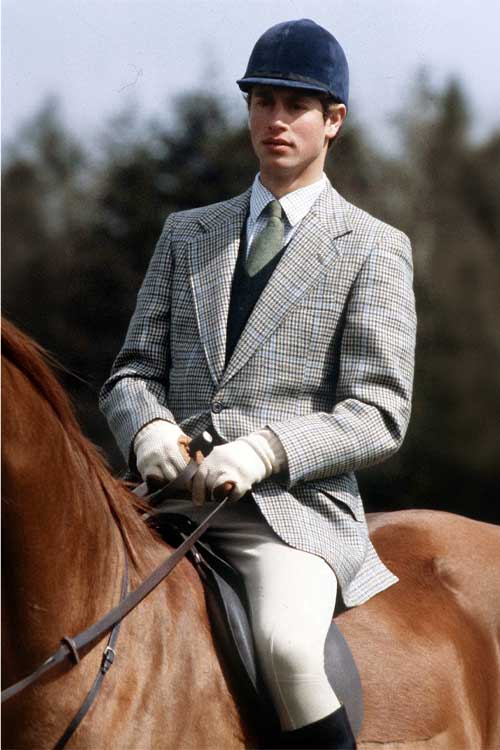
William Fox-Pitt – the British eventing rider, showcases how traditional equestrian wear translates to high-performance sports attire.
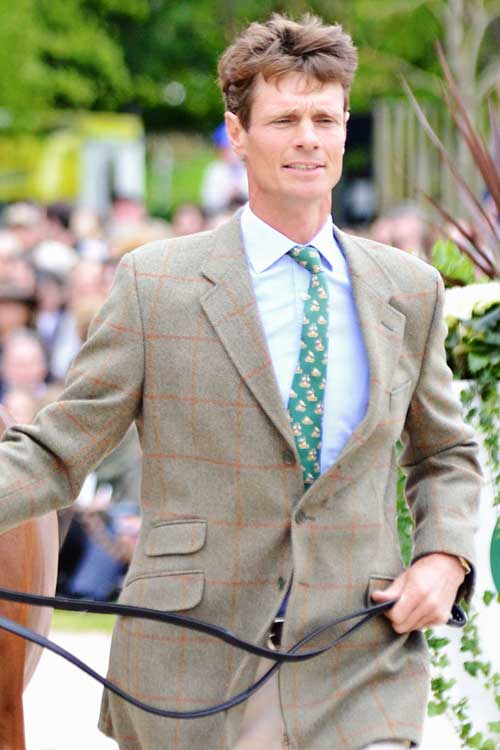
Equestrian Style and High Fashion
Nowadays, Hermès is the home of equestrian heritage in modern luxury fashion.
The brand’s ready-to-wear collections feature refined riding boots, leather accessories, and silk scarves with horse motifs, blending tradition with contemporary elegance.
Gucci, under Alessandro Michele, infuses equestrian elements with eclectic flair as the brand’s horsebit loafers and riding boots are reimagined in bold colours and materials.
Burberry’s collections reference British riding culture, and the brand’s iconic trench coat, originally designed for military horseback riding, is continually updated with modern cuts and fabrics.
Ralph Lauren has been instrumental in bringing equestrian chic to a global audience. His style embodies the intersection of American prep and British aristocratic fashion.
British Equestrian Style Global Influence
These global interpretations demonstrate the British equestrian style’s adaptability and enduring appeal across diverse cultures and climates.
United States
American equestrian style draws heavily from British traditions, particularly in New England and the Southern states.
The preppy look, epitomised by Ralph Lauren, incorporates elements of British riding wear into everyday fashion.
Tweed jackets, jodhpur boots, and equestrian-inspired accessories feature prominently in American interpretations.
The Kentucky Derby showcases a unique blend of Southern and British equestrian styles.
Men’s attire often includes seersucker suits, pastel shirts, and bold patterned ties, reflecting a more flamboyant take on traditional racing attire.
Argentina
Argentine polo style combines British equestrian tradition with South American flair. The gaucho influence is evident in the use of leather accessories and ponchos.
Argentine polo players often wear white jeans instead of traditional breeches, a style that has influenced casual equestrian wear globally.
The polo belt, featuring colourful woven patterns, has become an international fashion accessory, bridging Argentine and British equestrian styles.
Japan
Japanese designers and fashion enthusiasts have embraced British equestrian style, often refining and reinterpreting classic elements.
Brands like United Arrows and Beams Plus incorporate tweed fabrics, hunting jackets, and riding boots into their collections, adapting them for urban wear.
Japanese craftsmanship’s attention to detail has led to high-quality reproductions of classic British equestrian pieces, sometimes surpassing their original counterparts in construction and finish.
India
Indian equestrian style blends British colonial influences with traditional Maharaja dress.
Jodhpur breeches, originating in the Indian state of Jodhpur, have become a global equestrian staple.
The Nehru collar, a fusion of Indian and British styles, appears in formal equestrian-inspired wear.
Richly embroidered hunting jackets and ornate buttons reflect the opulence of Indian royal equestrian traditions.
Australia
Australian equestrian fashion adapts British styles to suit a warmer climate.
Lightweight, breathable fabrics replace heavy tweeds while maintaining traditional patterns and cuts.
The Akubra hat, Australia’s answer to the British flat cap, is common at equestrian events.
Initially designed for cattle stations, R.M. Williams boots have become popular in equestrian circles worldwide as a rugged alternative to traditional riding boots.
Equestrian Chic Style Evolution
18th Century
The origins of equestrian style can be traced back to the 18th century, a pivotal period marked by significant changes in British society and fashion.
As the aristocracy increasingly embraced country pursuits, particularly fox hunting, the need for practical yet elegant riding attire became paramount.
This shift began the equestrian style’s journey from functional sportswear to high fashion, laying the foundation for classic British tailoring.
In the early 1700s, riding dress often mirrored the elaborate and impractical fashions of the day.
Gentlemen would ride in long, flowing coats, powdered wigs, and breeches ill-suited for extended periods in the saddle.
However, as the century progressed, a distinct equestrian style began to crystallise, driven by the need for attire that could withstand the rigours of the hunt while maintaining an air of elegance.
Military Influence and the Iconic ‘Pink’
The military influence on equestrian style cannot be overstated. Many of the early innovations in riding wear came from cavalry uniforms designed for both style and utility on horseback.
The iconic scarlet hunting coat, or ‘pink’, evolved from military dress uniforms, combining visibility in the field with a sense of martial pride and discipline.
Late 18th Century
By the late 18th century, the transition from elaborate to understated elegance was underway, reflecting broader changes in men’s fashion.
This shift was epitomised by the adoption of the tailcoat for riding, a garment that would go on to influence formal wear for centuries to come.
The sartorial evolution saw the birth of iconic pieces such as the tailcoat and the hacking jacket, which would significantly impact formal and casual wear.
The Regency Period – Brummell’s Influence
The Regency period (1811-1820) saw further refinement of equestrian style. During this era, Beau Brummell, the arbiter of men’s fashion, advocated a more subdued and elegant approach to dress.
Brummell’s influence extended to riding attire, promoting well-cut, simple garments in muted colours.
This period saw the rise of the perfectly tailored riding coat, form-fitting breeches, and polished boots as the hallmarks of equestrian elegance.
19th Century
As the 19th century progressed, the equestrian style continued to evolve, influencing broader trends in men’s fashion.
The development of new fabrics and tailoring techniques allowed for greater comfort and functionality without sacrificing style.
Wool tweed, for instance, became a popular choice for riding jackets, offering durability and water resistance.
Equestrian Style on Modern Menswear
The impact of equestrian style on modern menswear silhouettes is profound and enduring.
The structured shoulder and nipped waist of a riding jacket can be seen in the classic cut of a man’s suit jacket.
The high-waisted, close-fitting nature of riding breeches influenced the development of modern trousers.
Even the concept of ‘sports jackets’ as a separate menswear category can be traced back to the need for specific jackets for riding and other country pursuits.
From the structured silhouette of a well-cut blazer to the timeless appeal of jodhpur boots, equestrian influences are ubiquitous in contemporary fashion.
These garments have transcended their original context, becoming symbols of sophistication and good taste in wardrobes worldwide.
In essence, the evolution of equestrian style from its 18th-century origins to its current form represents a journey from ostentation to refined elegance, from impracticality to functional sophistication.
It stands as a testament to the enduring influence of British aristocratic traditions on global fashion, continuing to shape our understanding of style, quality, and masculine elegance.
Conclusion
The equestrian chic style, rooted in British aristocratic tradition, continues to shape modern menswear.
From its 18th-century origins in practical riding attire, it has evolved into a sophisticated aesthetic that signifies refinement and heritage.
Key elements of equestrian style – the tailored blazer, jodhpur-inspired trousers, and polished riding boots – have become timeless staples in men’s fashion.
The influence extends beyond clothing to accessories, grooming, and overall deportment.
Traditional fabrics like tweed and worsted wool remain central to the style, now complemented by innovative, performance-enhancing materials.
Drawing from nature and military influences, the colour palette offers a versatile range of formal and casual wear.
Global interpretations of British Equestrian style, from American prep to Argentine polo wear, demonstrate its adaptability across cultures.
The equestrian chic style represents more than just clothing; it embodies a lifestyle of outdoor pursuits, respect for tradition, and old-money wealth.
As fashion evolves, the Equestrian look remains a touchstone of timeless masculine elegance.
Beyond Equestrian Chic Style
Knowing what is the Equestrian Chic fashion style is just a small step towards dressing like a successful, confident gentleman.
True fashion mastery lies in knowing and matching your body shape/type with your seasonal colour – skin, eye, and hair colours.
It requires understanding how to shop and pair the most ideal garments, footwear, and accessories from the most relevant, heritage brands.
This is paramount to being able to dress correctly by body shape, occasion, location, time of the day, and lifestyle.
Find Your Body Shape
Different garments flatter different physiques so discover your body shape now by taking our free body shape quiz for men.
Identify Your Best Colors
Fashion comes in a wide range of colours, but not every hue will complement your natural colouring so find out your ideal colours with our free seasonal colour quiz for men.
Then, learn how to dress by occasion, location, season, and even time of the day.
Dress for the Occasion
Understanding how to choose and style garments from relevant heritage brands, and style them by occasion, season, location, and body shape is crucial.
From casual weekends to formal events, each occasion requires a unique approach to styling.
To save time, headaches, and even money, get in touch with The VOU’s expert stylists now.
Get Expert Styling Advice
Take our comprehensive fashion style analysis for men, and let our expert stylists guide you in selecting and curating items of maximum impact in a wardrobe that communicates success and confidence.
Remember, owning luxury brands isn’t enough. To look stylish, confident, wealthy, and successful you must match your body shape, colour palette, season, occasion, location, time of the day, to perfection.
With these tools and expert guidance, you’ll not just wear the brand—you’ll master it, creating a wardrobe that truly reflects a unique fashion taste and many achievements.
With over twenty years of front-row fashion and styling events, collabs with haute-couture houses, and a PhD in Luxury Fashion, Laurenti is an expert in crafting personalised looks that depict old-money sophistication.
With years of expertise in high-end fashion collabs and a PhD in Sustainable Fashion, Ru specialises in eco-luxe wardrobes for the modern gentleman seeking understated refinement.


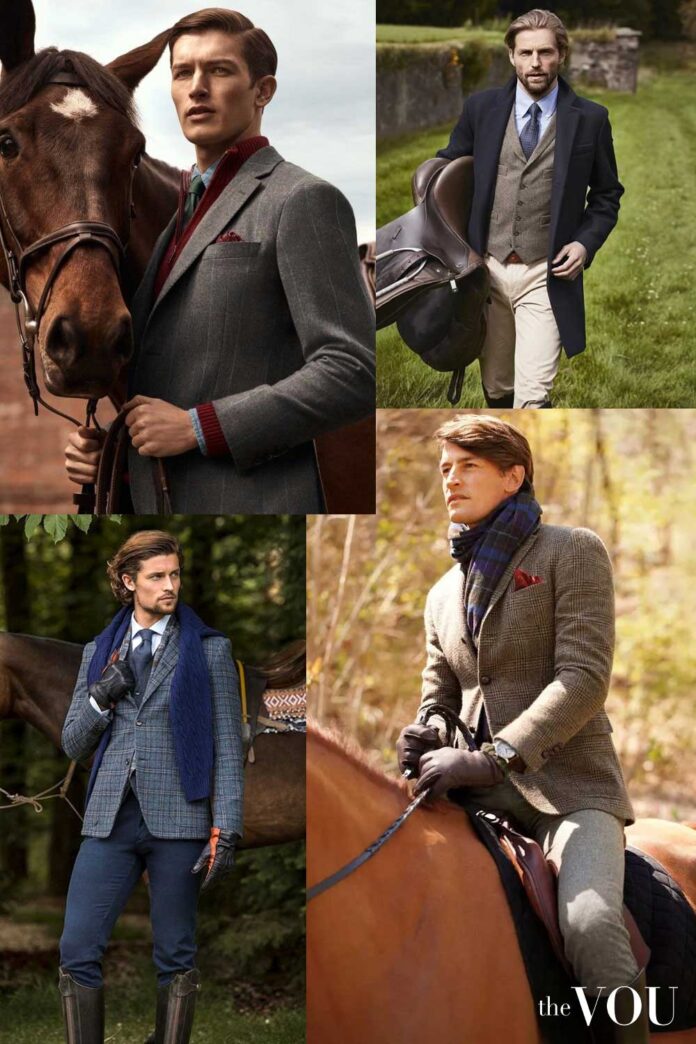
As a manufacturer of equestrian attire, we attest that this article is super accurate!